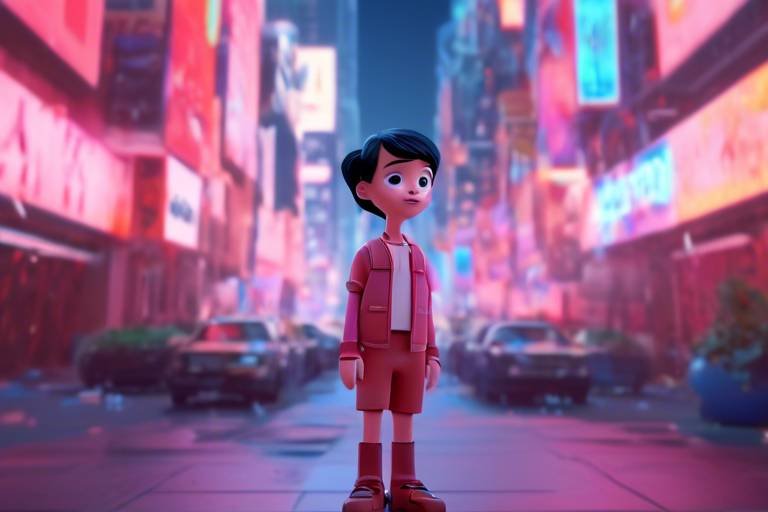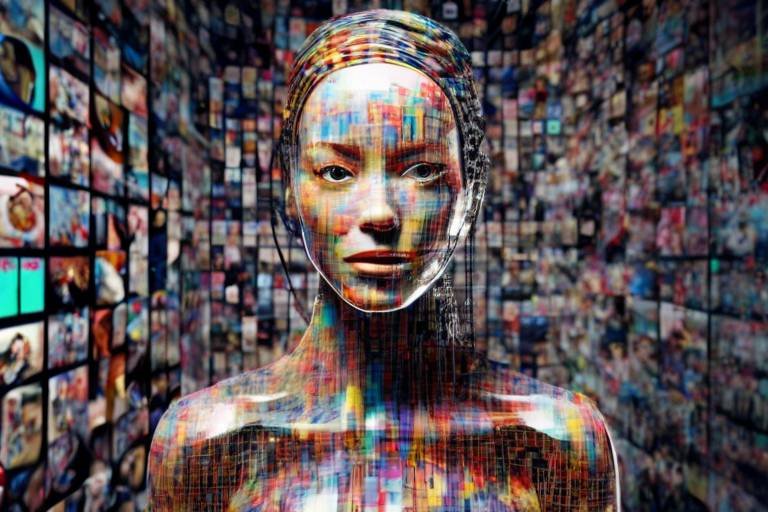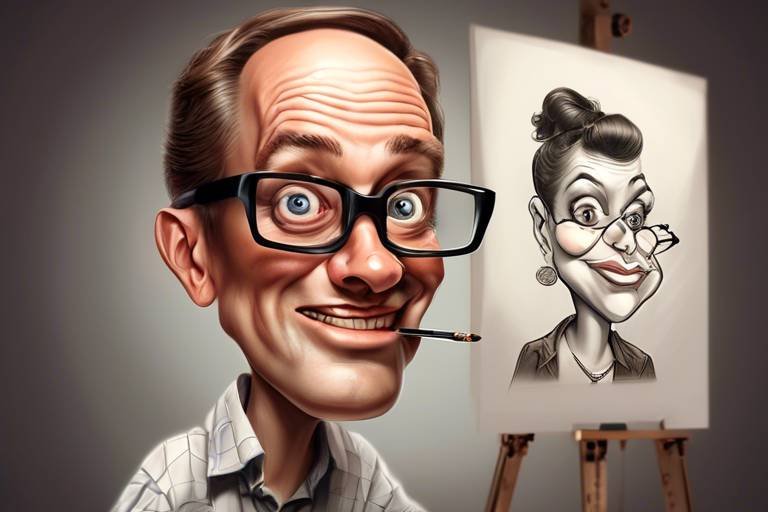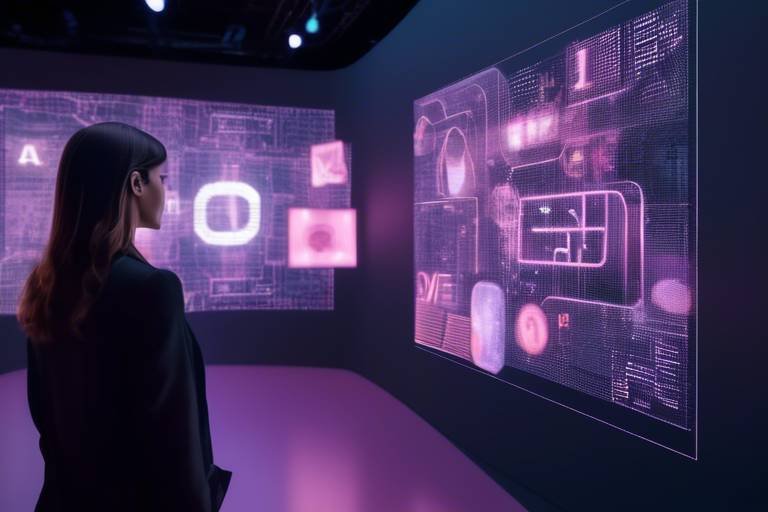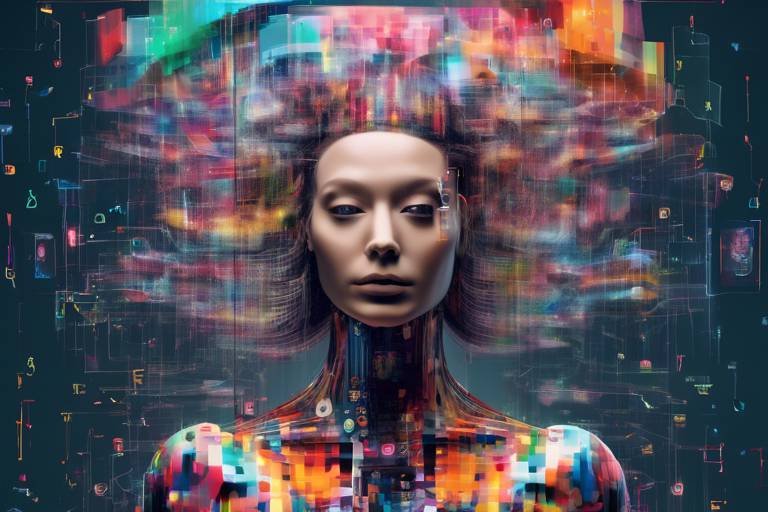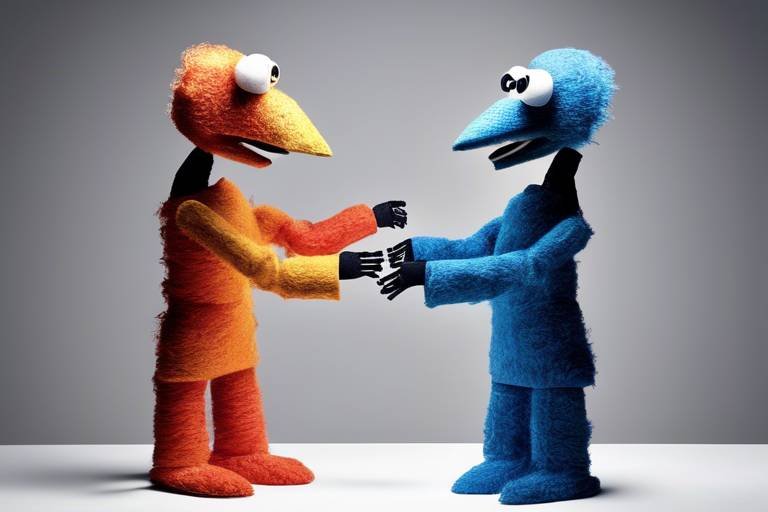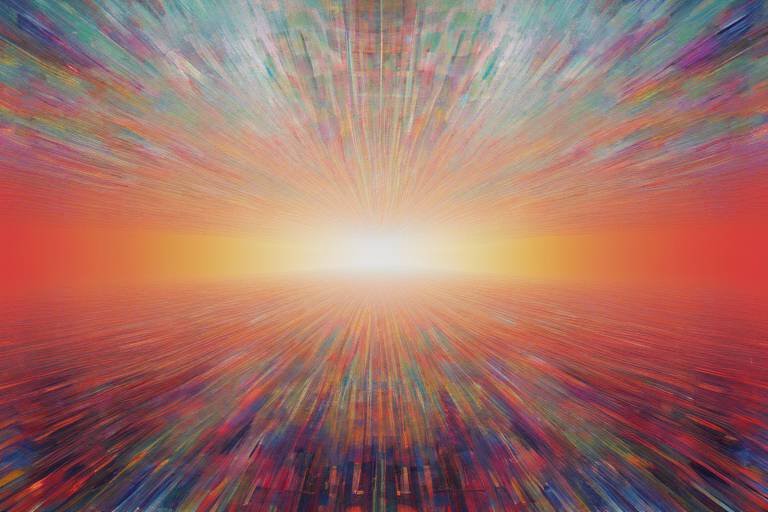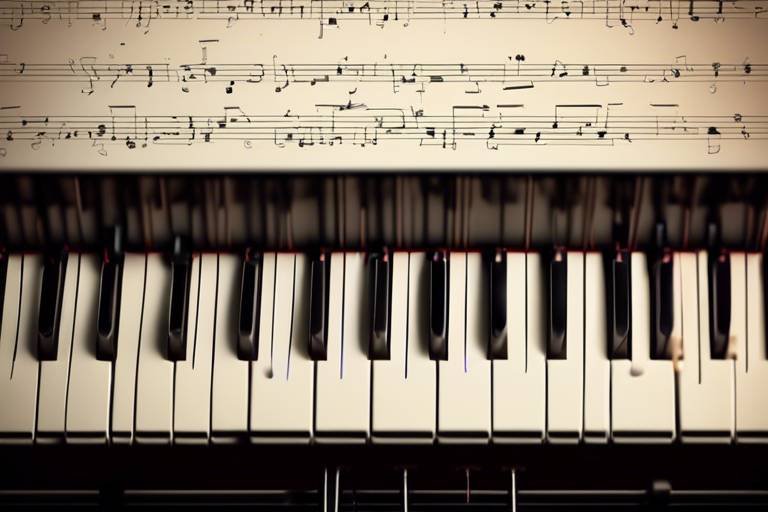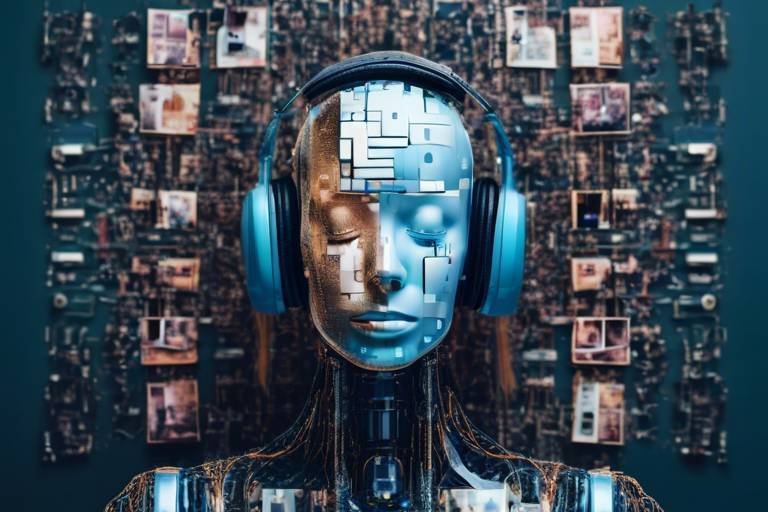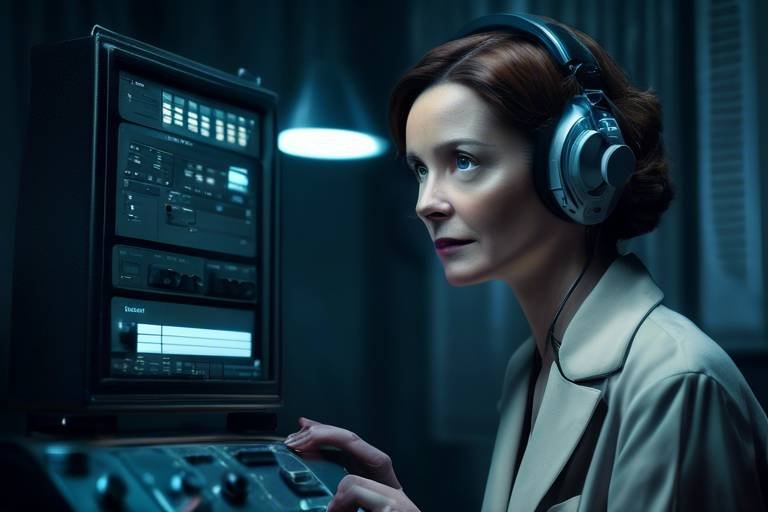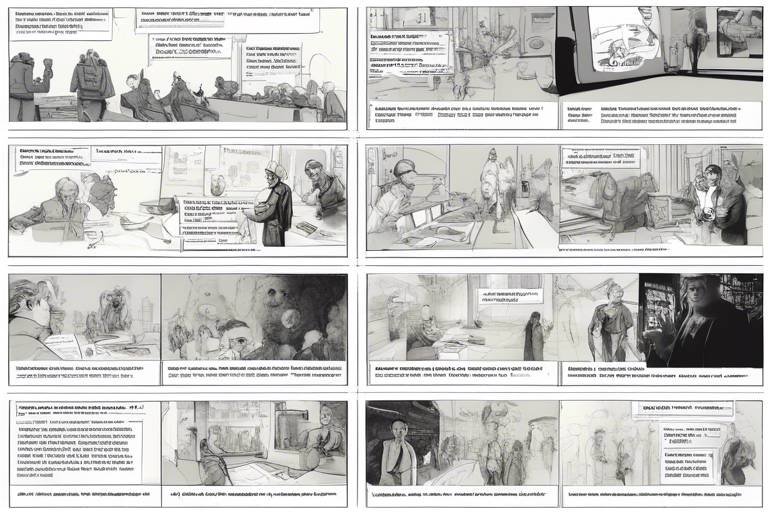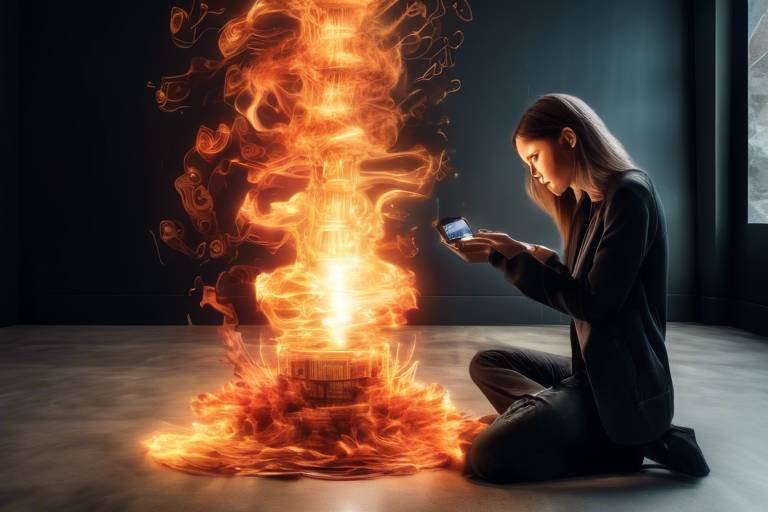Blending AI with Traditional Art Forms
In today's fast-paced world, the fusion of artificial intelligence with traditional art forms is nothing short of revolutionary. Imagine standing in front of a classic painting, only to realize that the brushstrokes were influenced by a complex algorithm. This intersection of technology and creativity not only enhances artistic expression but also preserves the rich tapestry of cultural heritage. It’s like having a conversation with the past while simultaneously paving the way for the future. So, how exactly does AI fit into the world of art? Let's dive deeper into this fascinating blend.
Art has always been a mirror reflecting the technological advancements of its time. From the invention of the camera, which challenged the traditional notion of painting, to the digital age where graphic design flourished, technology has continuously shaped artistic movements. Fast forward to today, and we find ourselves in an era where artificial intelligence is not just a tool but a vital partner in the creative process. This evolution sets the stage for a new wave of artistic expression, where the boundaries of creativity are being pushed further than ever before.
Artists are increasingly embracing AI as a collaborator rather than viewing it as a replacement for human creativity. With AI, artists can explore new avenues of inspiration, experiment with styles, and even generate ideas that they might not have considered on their own. It’s like having a brainstorming buddy who never runs out of ideas! For instance, artists can input certain parameters into AI programs, which then produce a variety of artistic interpretations. This collaboration not only sparks creativity but also challenges artists to think outside the box.
Generative art is a prime example of how AI can create unique pieces that question the very essence of authorship. In this realm, algorithms take center stage, producing artworks based on predefined rules set by the artist. This challenges traditional notions of creativity, as the line between the artist and the machine begins to blur. Imagine an artist crafting a set of guidelines and then stepping back to watch as the AI creates something entirely unexpected. It’s a thrilling dance between human intuition and machine logic!
Machine learning plays a crucial role in this creative partnership. By analyzing existing artworks, machine learning algorithms can identify patterns, styles, and techniques that can be mimicked or transformed into something new. This capability expands the boundaries of artistic creation, allowing for a rich tapestry of innovation. Artists can now harness the power of machine learning to create pieces that resonate with audiences on multiple levels, all while maintaining their unique voice.
Beyond creation, AI is also making waves in the realm of art restoration. Traditional artworks often suffer from the ravages of time, but with the help of AI, these pieces can be meticulously restored to their former glory. Algorithms can analyze the original colors, textures, and techniques used by the artists, allowing restorers to make informed decisions about how to bring a piece back to life. This not only preserves cultural heritage but also ensures that future generations can appreciate the beauty of these works.
There are numerous examples of artists who have successfully integrated AI into their work. For instance, artist Refik Anadol uses AI to create stunning visualizations that blend data and art, resulting in immersive experiences that captivate audiences. Similarly, the collaboration between artists and AI platforms like DeepArt and Runway ML has led to groundbreaking pieces that challenge our understanding of creativity. These case studies showcase innovative approaches that highlight the potential of AI in traditional art forms.
While the integration of AI into art opens up exciting possibilities, it also raises important ethical questions. Issues of originality and copyright come to the forefront as we navigate this new landscape. Who owns the rights to a piece created by an AI? Is it the artist who programmed the machine, or the machine itself? These questions are crucial as we consider the implications of AI-generated art on traditional artists and the art community as a whole.
The legal landscape surrounding copyright and ownership of AI-assisted artworks is still evolving. As artists increasingly rely on AI, the need for clear guidelines becomes paramount. For example, if an AI generates a piece based on an artist’s style, does the artist have the right to claim ownership? These questions highlight the need for a dialogue between artists, technologists, and legal experts to establish a framework that respects the contributions of both human and machine.
Looking ahead, the relationship between AI and traditional art is poised to grow even more complex. As technology continues to advance, we may see a future where AI not only assists in the creative process but also becomes a source of inspiration in its own right. This could lead to new artistic movements that embrace the capabilities of AI while honoring the traditions of the past. The question remains: how will we define art in an AI-driven world? Only time will tell, but one thing is certain—this is just the beginning of an exciting journey.
- What is generative art? Generative art refers to artwork created through algorithms, where the artist sets parameters for the AI to follow, resulting in unique creations.
- Can AI create art independently? While AI can generate art based on learned patterns, it typically requires human input to set guidelines and parameters.
- How does AI impact traditional artists? AI can serve as a tool for inspiration and collaboration, but it also raises questions about originality and copyright.
- Is AI art considered real art? This is subjective; many believe that art created with AI is a legitimate form of expression, while others may argue it lacks the human touch.

The Evolution of Art through Technology
The journey of art is as old as humanity itself, evolving through countless movements and styles, each influenced by the tools and technologies available at the time. From the ancient cave paintings of Lascaux to the intricate sculptures of the Renaissance, technology has always played a pivotal role in shaping artistic expression. Fast forward to the present day, and we find ourselves at a fascinating crossroads where traditional art forms meet the cutting-edge innovations of artificial intelligence.
Historically, each significant technological advancement has sparked a new wave of creativity. For instance, the invention of the printing press in the 15th century revolutionized the way art was disseminated, making it accessible to the masses and paving the way for the spread of ideas and styles across Europe. Similarly, the advent of photography in the 19th century challenged artists to rethink their roles; it was no longer enough to simply replicate reality. Instead, they began to explore abstraction and expressionism, leading to the birth of modern art movements.
Today, we stand on the brink of another transformative era, driven by the rise of artificial intelligence. This technology is not merely a tool; it acts as a catalyst for creativity, enabling artists to push boundaries and explore new frontiers. Imagine an artist sitting in front of their canvas, not alone but accompanied by an intelligent system that offers suggestions, generates new ideas, or even creates entire pieces based on the artist's style. This symbiotic relationship between human creativity and machine intelligence is reshaping the landscape of art.
Moreover, the integration of AI in traditional art forms is not about replacing the artist but enhancing their capabilities. Artists can now leverage machine learning algorithms to analyze vast datasets of existing artworks, unlocking patterns and styles that may have gone unnoticed. This process not only broadens their creative horizons but also deepens their understanding of art history and theory.
As we delve deeper into this intriguing intersection of technology and art, it's essential to recognize the profound implications it has on our cultural heritage. While AI can generate new forms of artistic expression, it also raises questions about authenticity and authorship. Is a piece created with the help of AI still considered traditional art? Or does it belong to a new category altogether? These questions challenge our perceptions and invite us to reconsider what it means to be an artist in the digital age.
In summary, the evolution of art through technology has always been a dynamic and reciprocal relationship. As we embrace the potential of AI, we must also honor the rich tapestry of traditional art forms that have come before. The future of art lies in this blend of innovation and tradition, where creativity knows no bounds.

AI as a Creative Partner
In the vibrant world of art, the integration of artificial intelligence (AI) has sparked a revolution that artists are eagerly embracing. Imagine having a collaborator who never tires, offers endless inspiration, and can analyze vast amounts of data in seconds. This is what AI brings to the table—a unique partnership that enhances creativity and pushes the boundaries of artistic expression. Artists are no longer limited to their own imaginations; they now have a digital muse that can generate ideas, suggest techniques, and even help in the execution of their visions.
Consider the process of creating a painting. Traditionally, an artist would spend hours, even days, conceptualizing their work, gathering materials, and carefully executing their vision. With AI, this process can be dramatically expedited. For instance, artists can use AI algorithms to generate color palettes, suggest compositions, or even create preliminary sketches based on the artist's style. This allows for a more fluid creative process where inspiration can strike at any moment. Instead of feeling stuck, artists can experiment with different ideas in real-time, leading to innovative outcomes that may not have been possible otherwise.
One fascinating aspect of AI as a creative partner is its ability to learn from existing artworks. By analyzing thousands of pieces from various genres and styles, machine learning algorithms can identify patterns and trends that human artists might overlook. This not only informs artists about current art movements but also helps them develop their own unique styles. The result? A fusion of traditional techniques with cutting-edge technology, creating pieces that are both contemporary and rooted in history.
Moreover, AI can serve as a tool for collaboration. Artists can engage with AI-generated artworks and use them as a foundation for their own creations. This collaborative approach can lead to unexpected results—an artist may start with an AI-generated image and then infuse it with their personal touch, creating a hybrid piece that reflects both human and machine creativity. This process is akin to a dance, where the artist and AI move in harmony, each influencing the other in a beautiful exchange.
However, this partnership is not without its challenges. As artists increasingly rely on AI, questions arise about the authenticity of their work. Is a piece created with AI still a product of human creativity? Or does the involvement of technology diminish its value? These are critical questions that artists must grapple with as they explore the boundaries of this new collaborative landscape.
In summary, AI is not just a tool; it is a creative partner that transforms the way artists work. By enhancing inspiration, streamlining processes, and fostering collaboration, AI opens up a world of possibilities that can lead to groundbreaking artistic expressions. As we continue to explore this intersection of technology and art, it becomes clear that the future of creativity is not just human or machine, but a harmonious blend of both.
- How does AI enhance the creative process for artists?
AI provides artists with tools for inspiration, analysis, and experimentation, allowing them to explore new ideas and techniques in their work. - Can AI create original art?
While AI can generate unique pieces, the originality often lies in how artists use these creations as a foundation for their own work. - What are the ethical implications of using AI in art?
Ethical considerations include questions of authorship, copyright, and the potential impact on traditional artistic practices.

Generative Art and Its Impact
Generative art is not just a trend; it’s a revolutionary movement that is reshaping the landscape of creativity. Imagine an artist sitting in front of a canvas, but instead of using a brush, they are programming a computer to create stunning visuals. This intersection of technology and artistry blurs the lines between the creator and the created, raising fascinating questions about authorship and originality. As algorithms generate unique pieces of art, they challenge our traditional notions of what it means to be an artist. Are we still the sole creators, or have we become mere facilitators of a new form of expression?
The impact of generative art extends beyond just aesthetics. It opens up a world of possibilities where artists can explore complex patterns, colors, and forms that might be impossible to achieve manually. For instance, consider how generative algorithms can analyze vast datasets of existing artworks, learning from styles and techniques to produce something entirely new. This is akin to a chef experimenting with flavors; by understanding the ingredients, they can create innovative dishes that surprise and delight. In the same way, artists can push their creative boundaries, using AI as a partner rather than a replacement.
Moreover, generative art has found its way into various domains, from music to architecture, proving that its influence is far-reaching. In music, for example, composers are using algorithms to create symphonies that evolve over time, offering listeners a unique experience with each performance. Similarly, architects are employing generative design principles to develop structures that are not only visually striking but also environmentally sustainable. This cross-pollination of ideas fosters a rich dialogue between disciplines, encouraging artists to think outside the box.
However, with great power comes great responsibility. The rise of generative art prompts us to examine the implications of this technology on traditional art forms. As we embrace these new tools, we must also consider the ethical dimensions. Who owns the rights to a piece created by an algorithm? Is it the artist who programmed the software, the software itself, or the data that was fed into it? These questions are not merely academic; they have real-world consequences for artists, collectors, and the industry as a whole.
In conclusion, generative art is a fascinating frontier in the world of creativity. It empowers artists to explore new realms of expression while challenging our understanding of authorship and originality. As we continue to navigate this evolving landscape, it’s essential to engage in conversations about the ethical implications and to celebrate the innovative spirit that drives this artistic revolution.
- What is generative art? Generative art refers to artwork created with the use of autonomous systems, often involving algorithms and computer programming.
- How does AI influence generative art? AI can analyze existing artworks and generate new pieces, allowing artists to experiment with styles and forms that may not be possible through traditional methods.
- What are the ethical concerns surrounding generative art? Key concerns include questions of copyright, ownership of AI-generated works, and the impact on traditional artists.

The Role of Machine Learning
Machine learning has become a pivotal force in the realm of art, acting as a bridge between traditional techniques and modern technology. Imagine a world where a machine can analyze the brush strokes of Van Gogh or the color palettes of Monet, learning the nuances that make their works so iconic. This is not just wishful thinking; it’s happening right now. By utilizing complex algorithms, machine learning systems can dissect existing artworks, identifying patterns, styles, and techniques that define various art movements. This analysis allows artists to tap into a vast reservoir of creativity, pushing the boundaries of what’s possible in their own work.
One fascinating aspect of machine learning in art is its ability to create entirely new pieces based on the learned data. For instance, an artist might input a series of paintings from the Renaissance period into a machine learning model. The model can then generate original artworks that mimic the style, while also incorporating modern elements. This fusion of old and new not only enhances the creative process but also challenges the very concept of authorship. When a machine produces a piece of art, who is the true artist? Is it the machine, the programmer, or the artist who provided the inspiration? These questions provoke thought and discussion in the art community.
Moreover, machine learning is not limited to just creating new art; it also plays a crucial role in art restoration. By analyzing damaged or deteriorated artworks, machine learning algorithms can predict what the original colors, shapes, and textures might have looked like. This predictive capability enables restorers to bring back the vibrancy of a piece that may have been lost to time. It’s like having a time machine that allows us to glimpse into the past, preserving cultural heritage for future generations. The table below illustrates some key applications of machine learning in the art world:
| Application | Description |
|---|---|
| Art Creation | Generates new artworks by learning from existing styles and techniques. |
| Style Transfer | Applies the style of one artwork to another, creating unique combinations. |
| Art Restoration | Predicts original features of damaged artworks for accurate restoration. |
| Curatorial Assistance | Helps curators recommend artworks based on visitor preferences and historical data. |
In conclusion, the role of machine learning in art is multifaceted and ever-evolving. It serves as a powerful tool that enhances creativity while simultaneously preserving the rich tapestry of our cultural heritage. As artists continue to explore the potential of these technologies, we can only imagine the breathtaking creations that will emerge from this harmonious blend of tradition and innovation.
- What is machine learning in art? Machine learning in art refers to the use of algorithms to analyze and create artworks, enabling new forms of creativity and restoration techniques.
- Can machines create original art? Yes, machines can generate original art by learning from existing styles and techniques, although the question of authorship remains a topic of debate.
- How does machine learning assist in art restoration? Machine learning algorithms can analyze damaged artworks to predict original features, aiding restorers in accurately bringing pieces back to their former glory.
- What ethical considerations arise from AI in art? Ethical considerations include questions of originality, copyright issues, and the potential impact on traditional artists and their work.

AI in Art Restoration
When we think about art restoration, our minds often wander to skilled conservators meticulously working with brushes and solvents to bring life back to faded masterpieces. However, the introduction of artificial intelligence into this age-old process is nothing short of revolutionary. Imagine a world where technology not only assists in the restoration of art but enhances the very techniques that have been employed for centuries. AI is doing just that, and the implications are profound.
AI algorithms can analyze a vast array of data, including high-resolution images of artworks, to identify areas that require restoration. This capability allows for a precision that human eyes might miss. For example, AI can detect subtle color shifts or minute details that have been lost over time, enabling restorers to make informed decisions on how to proceed. The result? A restoration process that is not only more efficient but also more faithful to the original work.
One of the most exciting aspects of using AI in art restoration is its ability to simulate the original appearance of artworks. By utilizing machine learning, AI can be trained on a dataset of existing artworks to understand the typical characteristics of certain styles, periods, or artists. This means that when a piece is damaged, the AI can suggest how it might have originally looked, providing a valuable reference for restorers. Just think of it as having a virtual time machine at your disposal!
Furthermore, AI can assist in the documentation of restoration processes. With every brush stroke and decision made, AI can record data that helps create a comprehensive history of the artwork's restoration. This not only preserves the integrity of the restoration but also serves as an educational resource for future generations. Imagine being able to look back at the restoration process of a Van Gogh or a Rembrandt, understanding every choice made to bring the artwork back to life.
However, the integration of AI in art restoration is not without its challenges. There are ongoing debates about the authenticity of AI-assisted restorations. Can a piece be considered truly original if a machine played a significant role in its restoration? This question opens a Pandora's box of ethical considerations that the art world must grapple with. Nonetheless, the potential for AI to revolutionize art restoration is undeniable, and as technology continues to advance, so too will our ability to preserve cultural heritage.
In conclusion, as we embrace the fusion of technology and traditional art forms, AI stands out as a powerful ally in the quest for preserving our artistic heritage. By enhancing the restoration process, AI not only breathes new life into old masterpieces but also ensures that future generations can appreciate the beauty and history of these works. It's a partnership that holds the promise of a richer, more vibrant artistic landscape.
- What is AI art restoration? AI art restoration refers to the use of artificial intelligence technologies to analyze, restore, and preserve artworks, enhancing traditional restoration methods.
- How does AI improve the restoration process? AI improves the restoration process by providing precise data analysis, simulating original appearances, and documenting restoration efforts.
- Are there ethical concerns with AI in art restoration? Yes, there are ethical concerns regarding the authenticity of AI-assisted restorations and the implications for traditional artists and restorers.
- Can AI restore any type of artwork? AI can be applied to various types of artwork, including paintings, sculptures, and historical artifacts, but the effectiveness may vary based on the medium.

Case Studies of AI in Traditional Art
As we delve into the fascinating realm where artificial intelligence meets traditional art, it's essential to highlight some remarkable case studies that showcase this innovative synergy. One standout example is the collaboration between Refik Anadol, a media artist known for his stunning data-driven artworks, and the iconic Van Gogh Museum in Amsterdam. Anadol utilized AI algorithms to analyze Van Gogh's extensive body of work, creating a mesmerizing installation titled “Van Gogh: The Immersive Experience.” This project not only brought Van Gogh's paintings to life in a new, immersive format but also sparked conversations about the reinterpretation of classic art through modern technology.
Another noteworthy case is the work of Mario Klingemann, an artist who has been pushing the boundaries of creativity with AI for years. Klingemann's project, “Neural Glitch,” involved training neural networks on thousands of historical artworks. The result? A series of unique pieces that blend the essence of traditional art with the unpredictability of machine-generated aesthetics. This approach not only challenges our understanding of creativity but also raises questions about the role of the artist in an age dominated by algorithms.
Moreover, the AI Art Lab at the University of Southern California has been at the forefront of experimenting with AI in art. One of their key projects involved creating a generative art piece that reimagined the style of famous painters like Pablo Picasso and Claude Monet. By employing machine learning, the AI was able to produce artworks that echoed the distinctive styles of these masters while introducing novel elements that had never been seen before. This blending of the old with the new not only celebrates the rich history of art but also invites viewers to contemplate the future of artistic expression.
These case studies illustrate the profound impact AI can have on traditional art forms, acting as a catalyst for creativity and innovation. However, they also prompt us to consider the implications of such collaborations. As artists continue to explore the potential of AI, we must ask ourselves: What does it mean to be an artist in a world where machines can create? The answers may vary, but one thing is certain—AI is not simply a tool; it is becoming a creative partner that challenges our perceptions and expands the horizons of artistic expression.
- What is AI-generated art? AI-generated art refers to artworks created with the assistance of artificial intelligence algorithms, which can analyze existing styles and generate new pieces based on learned patterns.
- How does AI influence traditional art? AI influences traditional art by providing new tools for creativity, allowing artists to experiment with styles, and offering innovative ways to restore and preserve artworks.
- Are AI-generated artworks considered original? The originality of AI-generated artworks is a topic of debate, as it raises questions about authorship and the role of human creativity in the artistic process.
- Can AI replace traditional artists? While AI can assist and enhance artistic processes, it is unlikely to replace traditional artists, as human creativity and emotional expression remain irreplaceable.

Ethical Considerations in AI Art
The rise of artificial intelligence (AI) in the realm of art has not only sparked excitement but also raised a myriad of ethical considerations that artists, collectors, and society at large must grapple with. As we embrace the potential of AI to enhance creativity, we must also question the implications of its integration into traditional art forms. Are we crossing a line that separates human creativity from machine-generated outputs? This conundrum invites us to explore the complex landscape of originality, copyright, and the evolving role of traditional artists in an increasingly automated world.
One of the primary concerns revolves around originality. When an AI generates a piece of art, who is the true creator? Is it the programmer who designed the algorithm, the artist who provided the initial input, or the machine itself? This question challenges our traditional understanding of authorship and creativity. The art world has long celebrated the unique vision of individual artists, but AI blurs these lines, leading to a new paradigm where the definition of an artist may need to be redefined.
Furthermore, the issue of copyright looms large in discussions about AI-generated art. Existing copyright laws were crafted in a time when human creativity was the sole source of artistic production. As AI begins to play a significant role in creating artworks, the legal framework surrounding copyright is being tested. For instance, if an AI creates a stunning painting based on a dataset of thousands of existing works, who holds the rights to that painting? The original artists whose works were included in the dataset? The developers of the AI? Or is it a new category altogether? This legal ambiguity raises important questions about the protection of artists' rights and the potential for infringement.
Moreover, the impact on traditional artists cannot be overlooked. Many fear that the increasing reliance on AI could devalue human-made art or even replace artists altogether. While it’s true that AI can produce art at an astonishing pace, it lacks the emotional depth and personal experience that human artists bring to their work. The relationship between artist and audience is deeply rooted in the shared human experience, something that AI cannot replicate. Thus, it is crucial to strike a balance between embracing technology and preserving the unique qualities that define traditional art.
In light of these considerations, it is essential for stakeholders in the art community—artists, collectors, curators, and policymakers—to engage in an ongoing dialogue about the ethical implications of AI in art. This conversation should include:
- Establishing clear guidelines for the use of AI in artistic creation.
- Updating copyright laws to address the challenges posed by AI-generated works.
- Promoting awareness and education about the potential risks and rewards of AI in art.
By fostering a collaborative approach, we can ensure that the integration of AI in art not only enhances creativity but also respects the values and traditions that have shaped the art world for centuries. As we navigate this uncharted territory, let us remain vigilant in protecting the essence of human creativity while exploring the exciting possibilities that AI has to offer.
- What is the main ethical concern regarding AI in art?
The primary concern is about originality and authorship, questioning who is considered the true creator of AI-generated artworks. - How do copyright laws apply to AI-generated art?
Current copyright laws may not adequately address the complexities of ownership and rights concerning art created with AI assistance. - Can AI replace traditional artists?
While AI can create art, it lacks the emotional depth and personal experiences that human artists bring, making it unlikely to fully replace them. - What steps can be taken to address ethical issues in AI art?
Engaging in dialogue, establishing guidelines, and updating copyright laws are essential steps to navigate these ethical challenges.

Copyright Issues with AI-Generated Art
The rise of artificial intelligence in the art world has sparked a whirlwind of debates surrounding copyright issues. As AI-generated art becomes more prevalent, the question arises: who owns the rights to these creations? This dilemma is not just a legal conundrum but also a philosophical one, challenging our understanding of authorship and originality. Traditionally, copyright law has been clear-cut, attributing ownership to the human creator of a work. However, when an algorithm or machine learning model generates art, the lines blur significantly.
One of the primary concerns is whether AI can be considered an author under current copyright laws. In most jurisdictions, copyright protection is granted only to works created by human beings. This raises a crucial question: if an AI program creates a painting or a piece of music, can it hold copyright? Or does the credit go to the programmer who designed the AI, the user who prompted it, or perhaps no one at all? This ambiguity can lead to a host of legal challenges and disputes over ownership and rights.
Moreover, the use of existing artworks to train AI models adds another layer of complexity. AI systems often analyze thousands of pieces of art to learn styles, techniques, and trends. While this process can lead to innovative creations, it also raises concerns about derivative works. If an AI generates a piece that closely resembles a famous painting, does that infringe on the original artist's copyright? The answer is still murky, as courts around the world grapple with these issues.
To illustrate the complexities, let's consider a few scenarios:
- Scenario 1: An artist uses an AI tool to create a new piece of art. Who owns the copyright—the artist, the AI developer, or both?
- Scenario 2: An AI generates a painting that closely resembles a well-known artwork. Is this a case of copyright infringement?
- Scenario 3: A programmer creates an AI that generates unique artworks. Does the programmer retain rights to the AI's creations?
As these scenarios unfold, the legal system is forced to adapt. Some countries are beginning to explore legislation that addresses AI-generated works specifically, while others are still applying traditional copyright laws to modern dilemmas. For instance, in the United States, the Copyright Office has stated that works created by AI without human intervention do not qualify for copyright protection. This stance emphasizes the necessity of human involvement in the creative process to secure ownership rights.
In conclusion, the copyright issues surrounding AI-generated art are as intricate as the creations themselves. As technology continues to evolve, so too must our legal frameworks. Artists, programmers, and lawmakers must engage in ongoing discussions to navigate this new landscape, ensuring that the rights of creators—both human and machine—are respected and protected. The future of art may very well depend on how we resolve these pressing copyright challenges.
- Who owns the copyright for AI-generated art? Copyright ownership can be complex, often depending on the level of human involvement in the creation process.
- Can AI be considered an author under copyright law? Currently, most copyright laws do not recognize AI as an author, attributing rights to human creators instead.
- What happens if AI creates a piece that resembles existing artwork? This may lead to copyright infringement claims, depending on the similarities and the jurisdiction's laws.

The Future of Art in an AI-Driven World
As we stand on the brink of an artistic revolution fueled by artificial intelligence, the future of art is poised to undergo a transformation that is as exciting as it is unpredictable. Imagine a world where your favorite painter collaborates with an AI, creating breathtaking masterpieces that blend human emotion with machine precision. This fusion could redefine what it means to be an artist and challenge our very understanding of creativity.
One of the most intriguing aspects of this evolution is how AI can serve as a creative partner rather than a replacement for human artists. By analyzing vast amounts of data, AI can identify patterns and trends that might escape even the most seasoned creators. This capability allows artists to push the boundaries of their work, experimenting with styles and techniques that were previously unimaginable. As a result, the art world could see a surge in innovative pieces that capture the essence of both human experience and technological advancement.
However, this brave new world also raises questions about the nature of authorship. If an AI generates a piece of art, who owns it? Is it the programmer, the artist, or the AI itself? These questions are not just academic; they have real-world implications for copyright laws and the way we value artistic expression. As we navigate this uncharted territory, it is essential to establish guidelines that respect both the contributions of human artists and the capabilities of AI.
Moreover, the integration of AI in art is likely to influence the art market significantly. Collectors and galleries may need to rethink how they evaluate and price artworks. Will pieces created with AI command the same respect and value as those crafted by human hands? The answer remains to be seen, but what is clear is that the dialogue around art, value, and creativity will become increasingly complex.
To illustrate this point, let’s consider a few potential scenarios for the future of art in an AI-driven world:
- Enhanced Collaboration: Artists may form partnerships with AI systems, leading to a new genre of hybrid art that combines human intuition with algorithmic precision.
- Democratization of Art Creation: With AI tools becoming more accessible, individuals without formal artistic training could create stunning works, potentially leading to a more diverse art landscape.
- New Aesthetic Movements: As AI-generated art gains popularity, we may see the emergence of new movements that challenge traditional aesthetics and philosophies of art.
In conclusion, the future of art in an AI-driven world is not just about technology; it’s about human expression and the endless possibilities that arise when creativity meets innovation. As we embrace these changes, it’s crucial to maintain a dialogue about the implications of AI in art, ensuring that while we explore new frontiers, we also honor the rich tapestry of human creativity that has shaped our cultural heritage.
Q: Will AI replace human artists in the future?
A: While AI can assist and enhance the creative process, it is unlikely to replace human artists entirely. The emotional depth and personal experiences that human artists bring to their work are irreplaceable.
Q: How does AI influence the value of art?
A: The introduction of AI in art could lead to shifts in how artworks are valued, as collectors and galleries will need to consider the role of AI in the creation process.
Q: Are there ethical concerns regarding AI-generated art?
A: Yes, there are significant ethical considerations, including questions about authorship, copyright, and the potential impact on traditional artists.
Frequently Asked Questions
- What is the role of AI in traditional art?
AI serves as a creative partner for artists, helping them to explore new ideas, generate unique pieces, and even restore traditional artworks. By blending technology with traditional techniques, artists can enhance their creative processes while preserving cultural heritage.
- How has technology historically influenced art?
Throughout history, technology has been a driving force behind art movements. From the invention of the camera to digital tools, each technological advancement has reshaped how artists create and perceive art. Today, AI is the latest tool that continues this evolution.
- What is generative art?
Generative art involves using algorithms to create unique artworks. This form of art challenges traditional notions of authorship, as the artist collaborates with the machine to produce something entirely new and unexpected. It's like having a conversation with a computer that can paint!
- Can AI restore traditional artworks?
Yes, AI plays a crucial role in art restoration. By analyzing existing artworks, machine learning algorithms can help identify areas that need repair and suggest methods to preserve the original essence of the piece. This ensures that cultural heritage is maintained for future generations.
- What are the ethical implications of AI in art?
The integration of AI in art raises several ethical questions, including issues of originality and copyright. As AI-generated art becomes more prevalent, the lines between human and machine creation blur, prompting discussions about ownership and the value of traditional artistry.
- How does copyright law apply to AI-generated art?
The legal landscape surrounding copyright for AI-generated art is complex and still evolving. Generally, copyright laws are designed for human creators, which raises questions about whether AI can be considered an author. This is a hot topic among artists, lawyers, and technologists alike!
- What does the future hold for AI and traditional art?
The future of art in an AI-driven world is exciting and unpredictable. As technology continues to advance, we can expect more innovative collaborations between artists and AI, leading to new forms of expression and appreciation. It's like stepping into a new dimension of creativity!




